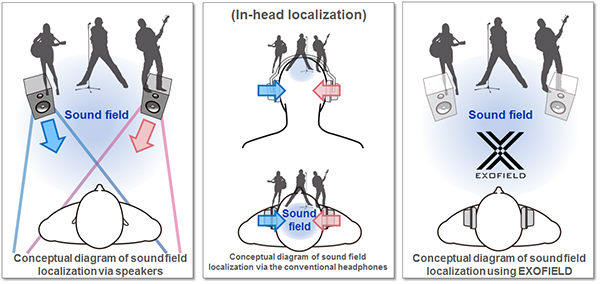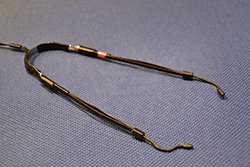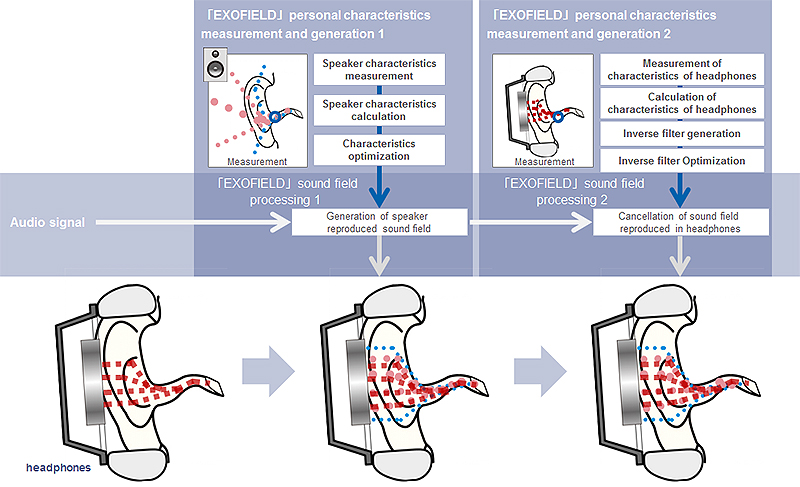NEWS RELEASE
March 14, 2017

Enabling reproduction and localization of sound field of speakers in a listening room with headphones
JVCKENWOOD Develops “EXOFIELD” Out-Of-Head
Localization Sound Field Processing Technology
Realizing optimization to individual users through measurement of personal characteristics
by using the industry’s first*1“in-ear audio microphone system”
and JVCKENWOOD’s unique “personal characteristics generation algorithm”
JVCKENWOOD Corporation (JVCKENWOOD) has newly developed “EXOFIELD” out-of-head localization sound field processing technology that enables reproduction of a sound field and localization of sound images created by speakers in a listening room when listening with headphones (19 related patents are pending).
With conventional headphones, sound images are localized in the head of users (in-head localization). With the new technology, JVCKENWOOD succeeded in out-of-head localization of sound images, as well as reproduction of a sound field and localization of sound images achieved in typical speaker listening even with headphones. The personal characteristics of users, such as the shapes of their ears and faces, as well as acoustic characteristics of speaker systems and listening rooms they use, were measured and audio signal processing optimal to each user was applied.
EXOFIELD: A term coined by combining EXO (external) and FIELD to express the expansion of users’ sound experience to a whole new level through reproduction of an unprecedentedly natural sound field.
*1: The first commercially available measurement system for out-of-head localization when listening with headphones. (Based on company data as of March 14, 2017.)
Purpose of Development
With the penetration of digital audio players and smartphones, more and more people are listening to music through headphones. Headphones are excellent at reproducing a delicate sound quality and nuances. However, sound transmitted to users through their right and left ears over conventional headphones is localized inside their heads. Thus, conventional headphones had a weakness in reproducing a spatial sound field and localization of sound images users experience when listening to music on speaker.
To deal with such shortcomings, JVCKENWOOD newly developed EXOFIELD, its unique out-of-head localization sound field processing technology that reproduce the sound field and localize sound images experienced in listening to music on speakers in a listening room even with headphones. It achieved this by leveraging its accumulated technologies in sound reproduction. The new technology uses sound field processing based on measurement of various acoustic characteristics including personal characteristics and excels at reproducing the depth and sense of distance of sound images, notably of those localized to the center position of sound images, which could not be achieved well with the general conventional out-of-head localization technology. As a result, the new technology creates a realistic sound field effect even when listening with headphones, as if the user is listening to music on speakers. In addition, users do not feel like music is playing in their ears. Therefore, EXOFIELD brings a natural sound listening experience to users who are experiencing uncomfortable sound pressure with headphones. In addition, EXOFIELD supports the reproduction of multi-channel audio sources, enabling three-dimentional sound field reproduction in headphones in a home theater or virtual reality environment, etc.
JVCKENWOOD, in an effort to deliver a new experience when listening with headphones realized by reproduction of an unprecedentedly natural sound field, will promote the development of services and products equipped with this technology.
Key Features
1. The technology can measure various acoustic characteristics of individuals, enabling optimal sound field processing for out-of-head localization sound fields
The conventional out-of-head localization technology for headphones performed arithmetic processing by using a standard head-related transfer function. As a result, headphones could not be adjusted to fit individual users, who have different shapes of ears and faces, etc. and could not deliver optimal performance for each user. JVCKENWOOD’s EXOFIELD, its unique technology, makes it possible to measure and analyze the personal characteristics of individual users, such as the shapes of their ears and faces, as well as all acoustic characteristics of audio speakers, headphones and listening rooms they use, etc. to perform audio signal processing that is optimally customized to individual users. Our technology creates the optimal sound field for each user unlike the conventional out-of-head localization sound field.

<Graphic illustration of sound localization>
2. Measurement using the industry’s first*1 in-ear audio microphone system allows creation of natural sound field in both open-back and closed-back headphones

<In-ear audio microphone system>
JVCKENWOOD newly developed an ultracompact in-ear audio microphone system using a MEMS microphone to measure the individual characteristics of users. The ultracompact microphone system put in the ear canal space makes it possible to accurately measure the shapes of head and ears as well as sound field characteristics in the ear canal of users. By enabling users to easily fix the position of the microphone system they are wearing to the ideal measurement location regardless of the individual difference in the shape of ears, we achieved stable and highly accurate measurement. In this way, we succeeded in providing a listening experience with a natural sound field in open-back headphones as well as closed-back headphones, for which the conventional out-of-head localization was considered relatively ineffective in reproducing natural sound.
3. Newly developed algorithm to generate personal characteristics can measure and automatically generate optimal acoustic characteristics in a short amount of time
The newly developed algorithm to generate personal characteristics can measure and automaticaly generate the optimal acoustic characteristics for each user in a short amount of time. The use of this algorithm can minimize the variation of the effect of the out-of-head localization sound field due to a difference in the measurement environment, such as listening room conditions, and incorrect wearing position of headphones. Accordingly, EXOFIELD can adapt to a wide range of measurement and use conditions by performing optimization processing of a transfer function calculated from measurement results.

<Conceptual diagram of EXOFIELD’s sound field processing>
1) Clarification of center sound image localization
We analyzed direct waves and reflection waves coming from speakers and corrected the cancelling out of sound due to the positional relationship between speakers and listners and the effects of sound reflection in a room. In this way, we succeeded in making the center sound image clearer, which was a problem with the conventional out-of-head localization technology. In addition, we realized sound image localization at the proper center position by fine-tuning the phase characteristics of each channel in inverse filter generation to cancel the sound field reproduced with headphones in out-of-head localization sound field generation.
2) Minimizing the variance of characteristics caused by incorrect wearing position of headphones
We optimized the change in frequency characteristics and a peak dip caused by an incorrect wearing position of headphones during generation of the inverse filter that cancels the sound field reproduced via headphones. This stabilized the variation in the localization effect caused by an incorrect wearing position of headphones.
3) Completing measurement and personal characteristics generation in a short time
We adopted the pulse method, a quick measuring method, for measurement of the impulse response and made it possible to complete measuring and generating the personal characteristics in a short amount of time. In an environment where measurement of a low-pass filter is subject to instability due to the effects of the surrounding environment and room conditions, EXOFIELD can generate stable low-pass characteristics in a short time by combining pre-measured room acoustic characteristics with personal characteristics.
4. Measured data and EXOFIELD processing can be uploaded to smartphone apps, etc.
This technology can be installed onto smartphone apps, etc. By installing EXOFIELD application software with personal properties data on mobile devices, users can enjoy an out-of-head localization sound field at any place.
5. Supporting a wide-range of applications such as high-resolution audio sources and multi-channel audio sources
EXOFIELD supports high-resolution audio sources and can process all audio signals into high-resolution audio sources. EXOFIELD can also reproduce stereo sound as well as multi-channel audio sources, enabling three-dimensional sound field reproduction via headphones in a home theater or virtual reality environment, etc. EXOFIELD will bring an unprecedented natural listening experience to users by offering a clear localization feeling, which was not reproduced adequately by the conventional three-dimensional sound field.
<Trademarks>
- EXOFIELD is a trademark or registered trademark of JVCKENWOOD.
- All other company names and product names are trademarks or registered trademarks of their respective holders.
For further information, please contact
- Public Investor and Shareholder Relations Department, Corporate Communication Division, JVCKENWOOD Corporation 3-12, Moriya-cho, Kanagawa-ku, Yokohama, Kanagawa 221-0022 Japan
Mail: prir@jvckenwood.com









